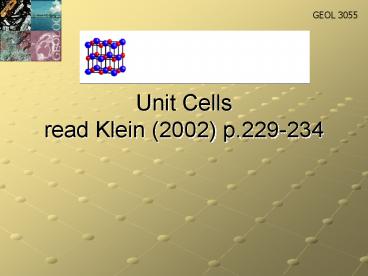Unit Cells read Klein 2002 p.229234 - PowerPoint PPT Presentation
1 / 11
Title:
Unit Cells read Klein 2002 p.229234
Description:
The external morphology of the crystals have dis-similar symmetry, ... 3-dimensional structure is the parallelepiped (with lattice points only at its corners) ... – PowerPoint PPT presentation
Number of Views:69
Avg rating:3.0/5.0
Title: Unit Cells read Klein 2002 p.229234
1
Unit Cellsread Klein (2002) p.229-234
2
Unit Cell
- After a basic look at symmetry of designs,
motifs, commas etc we can consider - The external morphology of the crystals have
dis-similar symmetry, so we can divide the
crystals into 6 crystal systems ( classes). - Looking again at translations
3
Unit Cell
2-dimensional
Plane lattice
Already looked at symmetry in 2-D
3-dimensional
Space lattice
- For Crystalline objects
Need 3-D Lattices Add an additional translation
direction (or vector) - in a different plane to
the 2-D net. Vector space referenced to 3 axes
known as x, y and z Unit cell vectors are a, b
and c (NOTE - x,y and z axes often called a, b
and c)
4
Unit Cell
- REMINDER A lattice is an imaginary pattern of
points in which every point has an environment
that is identical to that of any other point in
the lattice - a lattice has no specific origin and can be
shifted parallel to itself - 2 types
- A primitive space lattice, p is a parallelipiped
with lattice points only at its corners - If the unit cell is non-primitive, c then the
centering may occur on a pair of the opposite
faces of the unit cell (A, B or C), on all faces
of the unit cell (F) or in the center of the unit
cell (I)
5
Unit Cell
- Here we have 2 choices for a unit cell.
- 1st choice the diamond
- The 2nd choice has a point in the center
non-primitive unit cell
6
NOTE The shaded area is the smallest geometrical
unit
- Five plane lattices
- Parallelogram
- a b g 90o
- Rectangle
- a b g 90o
- Diamond
- a b g 90o,60o,120o
- Rhombus
- a b g 60o, 120o
- Square
- a b g 90o
7
Unit Cell
- Notice that the various unit cells are compatible
with symmetry elements or with combinations of
these.
8
Unit Cell
- In 3-dimensional crystalline patterns the choice
of unit cell is generally made according to the
following - Rule 1 Edges of unit cells, if possible, should
coincide with symmetry axes of lattice - Rule 2 Edges should be related to each other by
the symmetry of the lattice - In all cases, the smallest possible cell should
be chosen.
9
Unit Cell
- The most general 3-dimensional structure is the
parallelepiped (with lattice points only at its
corners) - 3 unequal angles that are not 90º, 60º or 120o
- 3 unequal edges a b c
Note Space lattice has three directions - a,
b, c
g
- Convention
- is angle between b and c
- b is angle between a and c
- g is angle between a and b
10
Unit Cell
- Any regular 3-dimensional array can be outlined
by a primitive unit cell (where points are on the
lattice corners) - Often desirable to choose a non-primitive unit
cell (according to rule 1 and 2) coincident with
symmetry axes and related by symmetry elements - The space lattices compatible with the 32
point-groups (lattice arrangements) are known as
the 14 Bravais Lattices (variations of the 5
plane lattice nets along a 3rd direction). - The 14 different lattice types shown on p 230 -
231 of Klein textbook - These represent the only possible ways arranged
in 3 dimensions - The 14 Bravais lattices can be split into 6
crystal systems
11
Triclinic
Monoclinic
- Possible combinations
Primitive unit cell
Orthorhombic
Hexagonal
Non-primitive unit cell
Tetragonal
Auguste Bravais 1811-1863
Isometric cubic system































